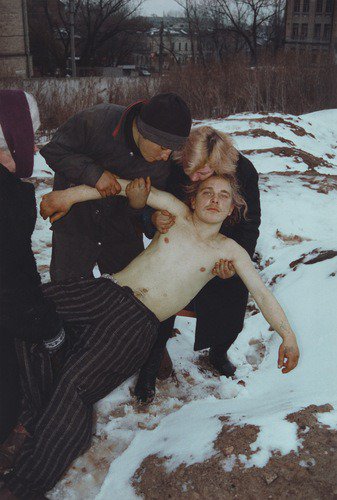Boris Mikhailov
dal 25/5/2011 al 4/9/2011
Segnalato da
25/5/2011
Boris Mikhailov
The Museum of Modern Art - MoMA, New York
Ukrainian-born Mikhailov is one of the leading photographers from the former Soviet Union. For over 40 years, Mikhailov has explored the position of the individual within the mechanisms of public ideology, touching on such subjects as Ukraine under Soviet rule, the living conditions in post-communist Eastern Europe, and the fallen ideals of the Soviet Union.This exhibition, which features some 20 works, is selected from the larger body of work of Case History, which comprises 400 photographs and was published as a book in 1999. Arguably his most challenging body of work, it explores the deeply troubling circumstances of bomzhes - the homeless - a new class that emerged after the collapse of the Soviet Union in 1991. In 1996, after spending time abroad, he returned to Kharkov, which seemed like a changed city, with foreign ads and the glitz of a new western capitalist facade.

The Museum of Modern Art presents Boris Mikhailov: Case History, the first presentation dedicated entirely to the artist’s seminal series Case History (1997–98) in an American museum, from May 26 to September 5, 2011.
Ukrainian-born Mikhailov (b. 1938) is one of the leading photographers from the former Soviet Union. For over 40 years, Mikhailov has explored the position of the individual within the mechanisms of public ideology, touching on such subjects as Ukraine under Soviet rule, the living conditions in post-communist Eastern Europe, and the fallen ideals of the Soviet Union. Although deeply rooted in a historical context, his work incorporates profoundly engaging and personal narratives of humor, lust, vulnerability, aging, and death. The exhibition is organized by Eva Respini, Associate Curator of Photography, The Museum of Modern Art.
This exhibition, which features some 20 works, is selected from the larger body of work of Case History, which comprises 400 photographs and was published as a book in 1999. Arguably his most challenging body of work, it explores the deeply troubling circumstances of bomzhes – the homeless – a new class that emerged after the collapse of the Soviet Union in 1991. In 1996, after spending time abroad, he returned to Kharkov, which seemed like a changed city, with foreign ads and the glitz of a new western capitalist façade. Whereas most mainstream media focused on the new capitalists and rising oligarchs of the former Soviet republics, Mikhailov’s pictures describe the circumstances of a largely invisible underclass. Set against the bleak backdrop of the industrial city of Kharkov, his life-size color photographs chronicle the oppression, devastating poverty, and everyday reality of a disenfranchised community living on the margins of the Ukraine’s new economic regime. Many of his subjects display their wounds, rashes, tattoos, and growths.
For Mikhailov the act of photographing was partly born out of a sense of responsibility: Case History records post-Soviet realities, in stark contrast to the previous histories of the Ukraine (1930s famine, war, Soviet losses in World War II) that went undocumented. One of the most haunting documents of post-Soviet urban conditions, these unforgettable pictures capture this new reality with poetry, clarity, and grit. The large size of Mikhailov’s pictures is in keeping with the scale of contemporary photography, creating a visceral and immersive viewing experience. Ms. Respini states, “Mikhailov inhabits the worlds of social documentarian and contemporary artist. It is partly the tension between these two roles that makes the work so complex and powerful.”
Case History also explores the complicated relationship between photographer and subject. The photographs are collaborations, sometimes the result of a spontaneous moment, other times directed by the artist. Central to the exhibition is the seven-part work the artist calls ―requiem.‖ The mannered posing of the people in his pictures exposes the constructed nature of the photographs, challenging the idea of objective truth and authenticity implied by documentary photography. For Mikhailov, photographic seeing is an accountable act, and viewers participate in this act. With these pictures, Mikhailov implicates himself – and the viewers – in the act of looking.
Mikhailov lives and works in Berlin and Kharkov. His work has been widely exhibited internationally, with solo exhibitions at the Stedelijk Museum in Amsterdam; Haus der Kulturen der Welt, Berlin; Saatchi Gallery, London; and Institute of Contemporary Art, Boston; and in group exhibitions at Tate Modern; London’s Photographer’s Gallery; and the São Paolo and Venice biennials. He is the recipient of numerous awards and prizes, including the prestigious Hasselblad Foundation Award and Citibank Photography Prize, granted for Case History. Mikhailov was included in MoMA’s New Photography series in 1993 with his series of photographs titled U Zemli (On the Ground). MoMA has been collecting and exhibiting his work ever since.
Press Contact: Daniela Stigh, 212-708-9747 or daniela_stigh@moma.org
Margaret Doyle, 212-408-6400 or margaret_doyle@moma.org
Image: Untitled, from the series Case History (1997-98)
© All rights reserved Boris Mikhailov 2011 United States
Chromogenic color print 58 7/16 x 39 3/16" (148.5 x 99.5 cm) Courtesy The Museum of Modern Art. Acquired through the generosity of Howard Stein. © 2011 Boris Mikhailov
Opening 26 may 2011
The Museum of Modern Art
11 West 53 Street, New York, NY
Hours: Wednesday through Monday, 10:30 a.m.–5:30 p.m. Friday, 10:30 a.m.–8:00 p.m. Closed Tuesday
SUMMER HOURS JULY 1—SEPTEMBER 3: Sunday through Wednesday, 10:30 a.m.-5:30 p.m.
Thursday through Saturday, 10:30 a.m.-8:30 p.m. (except Saturday July 9, the Museum closes at 5:30 p.m.)
Museum Admission: $20 adults; $16 seniors, 65 years and over with I.D.; $12 full-time students with
current I.D. Free, members and children 16 and under. (Includes admittance to Museum galleries and film
programs). Target Free Friday Nights 4:00–8:00 p.m. (JULY 1—SEPTEMBER 2: TARGET FREE FRIDAY NIGHTS
4:00-8:30 p.m.)



